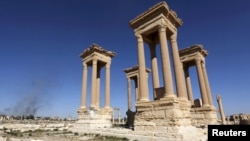The Islamic State militant group has destroyed parts of a Roman amphitheater in Syria's ancient city of Palmyra, according to Syria's state run news agency.
In addition to the facade of the second-century amphitheater, IS destroyed the Tetrapylon, an ancient cubic-shaped Roman monument. The agency did not give further details or say when the monuments were blown up.
Syrian antiquities chief Maamoun Abdulkarim provided Reuters with satellite images that show the Tetrapylon has been largely destroyed. The images show only four of the Tetrapylon's 16 columns still upright.
Syrian opposition monitors also confirmed Islamic State's destruction of the ancient remains.
Abdulkarim said the images show the damage was done between December 26 and January 10.
The United Nations Educational, Scientific and Cultural Organization (UNESCO) issued a statement Friday condemning the destruction in Palmyra.
"This destruction is a new war crime and an immense loss for the Syrian people and for humanity," said UNESCO Director General Irina Bokova.
IS seized Palmyra in 2015 and maintained control of it until the Syrian military, supported by Russia, ousted the militants from the city last March.
When IS previously controlled Palmyra, it destroyed other ancient monuments in, including the city's iconic 1,800-year-old arch.










